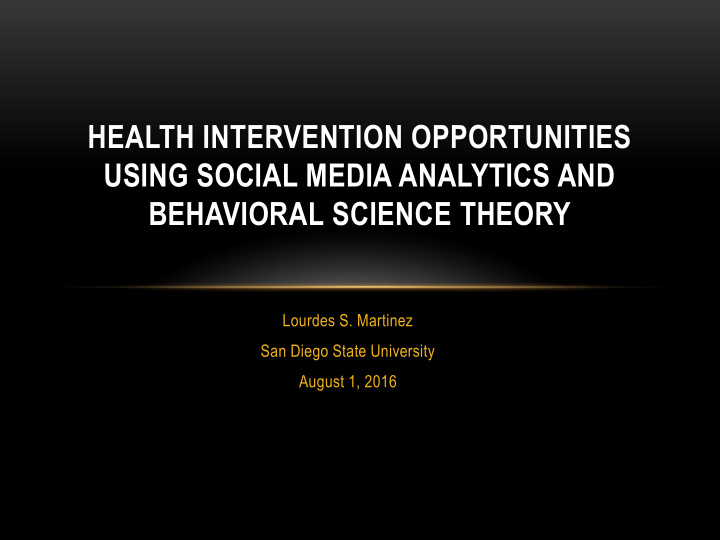



HEALTH INTERVENTION OPPORTUNITIES USING SOCIAL MEDIA ANALYTICS AND BEHAVIORAL SCIENCE THEORY Lourdes S. Martinez San Diego State University August 1, 2016
BEHAVIOR AND HEALTH • Behavior plays key role in death and disease (Danaei et al, 2009) of individuals and others • Tobacco Diet • • Exercise Sexual behavior • • Avoidable injuries
BEHAVIOR CHANGE INTERVENTIONS • Require clear understanding of behavior and how to influence it (Glanz & Bishop, 2010) When effective, interventions that target behavior help • • Maintain or improve health Reduce risk of disease • • Manage disease and health-related conditions
INTERVENTIONS AND SOCIAL MEDIA • Increasingly popular platform for intervention (Hamm et al, 2013) with several benefits (Moorhead, 2013) • Cost-effective approach for promoting user interaction Peer-to-peer support • • Access to health interventions
BEHAVIORAL SCIENCE THEORY • Research area drawing from across several disciplines (e.g., communication, health, sociology, psychology, marketing, and economics) • Empirical evidence in support of using behavioral science theory to improve intervention effectiveness (Glanz & Bishop, 2010) • Use in tandem with social media analytics relatively unexplored
REASONED-ACTION APPROACH (adapted from Fishbein & Ajzen, 2010)
REASONED-ACTION APPROACH AND SOCIAL MEDIA ANALYTICS • Identify and target strongest determinant of intention Pro vs. anti social media messages • • Sort according to attitudinal, normative, or efficacy components Plot social media messages in geospatial context • • Compare with existing data on current rates of disease outbreaks Examine nature and density of social media messages and if they correspond with • geographical areas with higher rates of disease
ATTITUDINAL CONTENT
ATTITUDINAL CONTENT
NORMATIVE CONTENT
NORMATIVE CONTENT
EFFICACY CONTENT
EFFICACY CONTENT
REASONED-ACTION APPROACH AND SOCIAL MEDIA ANALYTICS • Identify and target underlying beliefs of primary determinant of intention Look for patterns in message strategies and argumentation that coincide with • geographical areas of higher compliance and less outbreaks Compare to patterns of message strategies and argumentation that consistent with • geographical areas of lower compliance and more outbreaks
REASONED-ACTION APPROACH AND SOCIAL MEDIA ANALYTICS • Deciding whether to intervene or not Change attitude/norms/efficacy? • • Remove environmental barriers? Launch reinforcement intervention? •
INTENTION-BEHAVIOR MATRIX Performance of Recommended Behavior NO YES Intention to Change outcome, Change outcome, normative, Perform NO normative, and self- and self-efficacy beliefs Recommended efficacy beliefs Behavior Improve skills. No intervention or launch Reduce/help overcome reinforcement intervention to YES environmental barriers maintain desirable behavior (adapted from Fishbein & Cappella, 2006)
REASONED-ACTION APPROACH AND SOCIAL MEDIA ANALYTICS
REASONED-ACTION APPROACH AND SOCIAL MEDIA ANALYTICS
CONCLUSION • Reasoned-action approach and social media analytics Potential to identify opportunities for intervention and communities at most need • • More research needed to determine added value over existing methods
REFERENCES • Danaei, G., Ding, E. L., Mozaffarian, D., Taylor, B., Rehm, J., Murray, C. J., & Ezzati, M. (2009). The preventable causes of death in the United States: comparative risk assessment of dietary, lifestyle, and metabolic risk factors. PLoS Med , 6 (4), e1000058. • Fishbein, M., & Cappella, J. N. (2006). The role of theory in developing effective health communications. Journal of Communication , 56 (s1), S1-S17. • Fishbein, M., & Ajzen, I. (2010). Prediction and change of behavior: The reasoned action approach. Glanz, K., & Bishop, D. B. (2010). The role of behavioral science theory in development and • implementation of public health interventions. Annual Review of Public Health , 31 , 399-418. • Hamm, M. P., Chisholm, A., Shulhan, J., Milne, A., Scott, S. D., Given, L. M., & Hartling, L. (2013). Social media use among patients and caregivers: a scoping review. BMJ open , 3 (5), e002819. • Moorhead, S. A., Hazlett, D. E., Harrison, L., Carroll, J. K., Irwin, A., & Hoving, C. (2013). A new dimension of health care: systematic review of the uses, benefits, and limitations of social media for health communication. Journal of Medical Internet Research , 15 (4), e85.
Recommend
More recommend